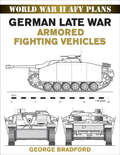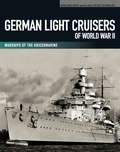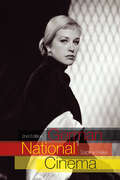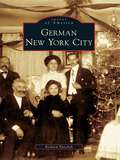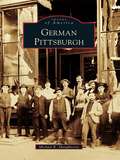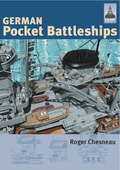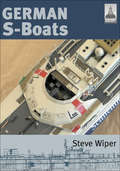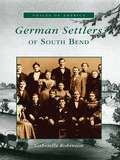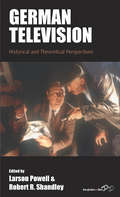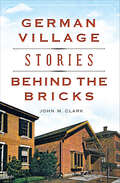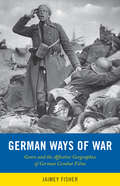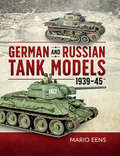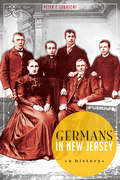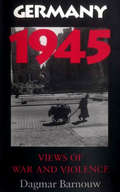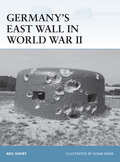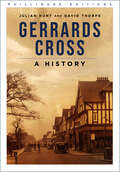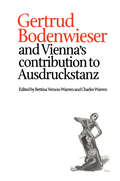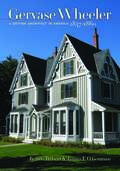- Table View
- List View
German Late War Armored Fighting Vehicles: World War II AFV Plans (AFV Plans)
by George BradfordFor modelers and WWIl enthusiasts, a collection of scale drawings of German combat vehicles. For armor modeling and military vehicle enthusiasts, this volume is filled with fine-scale drawings of Germany&’s late war armored vehicles including: • Pz. Kpfw. V Panther Tank • Pz. Kpfw. VI Tiger I and II • Pz. Jager Elephant Tank Destroyer • Sd.Kfz. 234/2 &“Puma&” Armored Car • Jagdtiger with Henschel suspension • And dozens more . . .
German Light Cruisers of World War II: Warships of the Kriegsmarine (Warships Of The Kriegsmarine Ser.)
by Gerhard Koop Klaus-Peter Schmolke&“An immensely interesting look&” at the Emden, Königsberg, Karlsruhe, Köln, Leipzig, and Nürnbergships &“from drawing board to destiny&” (War History Online). The warships of the World War II era German Navy are among the most popular subject in naval history with an almost uncountable number of books devoted to them. However, for a concise but authoritative summary of the design history and careers of the major surface ships it is difficult to beat a series of six volumes written by Gerhard Koop and illustrated by Klaus-Peter Schmolke. Each contains an account of the development of a particular class, a detailed description of the ships, with full technical details, and an outline of their service, heavily illustrated with plans, battle maps and a substantial collection of photographs. These have been out of print for ten years or more and are now much sought after by enthusiasts and collectors, so this new modestly priced reprint of the series will be widely welcomed. This volume is devoted to the six ships from Emden to Nürnberg that were built between the wars. They were primarily intended for commerce-raiding, but the war gave them few opportunities for such employment, although they did provide useful support for key naval operations in the Baltic and North Sea. Two were lost in the 1940 Norway campaign, but the remainder survived for most of the conflict. &“A ship-by-ship history of the cruisers. The text is supported by an excellent collection of plans and photographs. Overall this is a very impressive history of a fairly unimpressive set of warships.&”—HistoryOfWar.org
German National Cinema (National Cinemas)
by Sabine HakeGerman National Cinema is the first comprehensive history of German film from its origins to the present. In this new edition, Sabine Hake discusses film-making in economic, political, social, and cultural terms, and considers the contribution of Germany's most popular films to changing definitions of genre, authorship, and film form. The book traces the central role of cinema in the nation’s turbulent history from the Wilhelmine Empire to the Berlin Republic, with special attention paid to the competing demands of film as art, entertainment, and propaganda. Hake also explores the centrality of genre films and the star system to the development of a filmic imaginary. This fully revised and updated new edition will be required reading for everyone interested in German film and the history of modern Germany.
German Naval Camouflage, 1942–1945: 1942 - 1945
by John Asmussen Eric LeonSecond in &“the most complete and authoritative set of books ever written on the color schemes used by the Kriegsmarine throughout World War II&” (Great Models). This book completes a highly original and superbly illustrated two-volume survey of German naval camouflage and markings in the Nazi era. On first publication in 2012, the 1939-1941 volume was quickly recognized by warship enthusiasts and modelmakers as a major step forward in the understanding of a complex and much debated topic. It is already considered the standard reference, and this second volume is keenly awaited. Although a few crucial documents have recently come to light, this study is largely based on close scrutiny of all available photos, including many newly discovered, collated with the first-hand testimony of Kriegsmarine survivors. After decades of study, the authors are probably the world&’s leading experts, and their work challenges many accepted views, while greatly expanding the general understanding of the subject. The fruits of their labors are presented in the form of exquisite color illustrations of every scheme and variation for which evidence is available. This volume covers all major surviving ships down to destroyers from 1942 to the end of the war, and adds a new section on torpedo boats. While there can never be a last word on such an elusive and poorly documented subject, these two volumes will remain the most authoritative work in the field for many years to come.&“Impressive, wonderful and indispensable for both historians and modelers or naval wargamers.&” —Miniaturas JM
German New York City (Images of America)
by Richard PanchykGerman New York City celebrates the rich cultural heritage of the hundreds of thousands of German immigrants who left the poverty and turmoil of 19th- and 20th-century Europe for the promise of a better life in the bustling American metropolis. German immigration to New York peaked during the 1850s and again during the 1880s, and by the end of the 19th century New York had the third-largest German-born population of any city worldwide. German immigrants established their new community in a downtown Manhattan neighborhood that became known as Kleindeutschland or Little Germany. During the late 19th and early 20th centuries, much of the German population moved north to the Upper East Side's Yorkville and subsequently spread out to the other boroughs of the city.
German Pittsburgh (Images of America)
by Michael R. ShaughnessyGerman Pittsburgh explores the multifaceted cultural history of German-speaking immigrants and residents in the Greater Pittsburgh area. Today over one quarter of the city's residents claim German heritage, the largest ethnic group in the region. German-speaking Pittsburghers include names like H. J. Heinz, Honus Wagner, and the Kaufmanns, and they produced beloved Pittsburgh beers such as Iron City and Penn Pilsner. It might be surprising to know that German was an official language of the city at one time, and a daily German newspaper was printed from the mid-1800s up through World War II. Today remnants of the German-speaking community can be found on the North Side, the South Side, Troy Hill, and Mount Oliver, to name a few. German Pittsburgh provides an overview of the contributions that this diverse ethnic community has made and is making today in the city.
German Pocket Battleships (ShipCraft #Vol. 1)
by Roger ChesneauEverything the ship modeller needs to know about building a famous warship Numerous detailed plans and colour illustrations Focuses on very popular modelling subjects which are represented by a wide selection of kits The 'ShipCraft' series provides in-depth information about building and modifying model kits of famous warship types. Lavishly illustrated, each book takes the modeller through a brief history of the subject class, using scale plans to highlight differences between sisterships and changes in their appearance over their careers, then moves to an extensive photographic survey of either a high-quality model or a surviving example of the ship. Hints on building the model, and on modifying and improving the basic kit, are followed by a section on paint schemes and camouflage, featuring numerous colour profiles and highly-detailed line drawings. The strengths and weaknesses of available kits of the ships are reviewed, and the book concludes with a section on research references—books, monographs, large-scale plans and relevant websites. For the first volume in this series, the author has chosen the German 'pocket battleships' of WW2, the best-known of which was the Graf Spee of Battle of the River Plate fame. This innovative and infamous class of surface raiders has long been a popular subject for ship modellers, many manufacturers producing kits of the Graf Spee and the rather different Admiral Scheer and Ltzow. This book will show ship modellers how to turn their kits into something really special, but its unparalleled level of visual information will also appeal to the more general warship enthusiast. Roger Chesneau is a lifelong ship modeller and author of numerous naval books, including Ship Models in Plastic.
German Reconnaissance and Support Vehicles, 1939–1945 (Images of War)
by Paul ThomasThis WWII pictorial history illustrates the full range of Nazi vehicles used in reconnaissance and support missions throughout the war. The German military used reconnaissance and support vehicles widely in the Second World War. This book illustrates the full range of these vehicles with authoritative information and more than 200 rare wartime photographs. Both tracked and wheeled vehicles were employed for reconnaissance and screening. These included light tanks such as the Panzer I and Panzer II, armored cars such as the six- and eight- wheeled Schwerer Panzerspähwagen, and motorcycles such as the famous BMW R75 or the Zundapp KS750. In addition to their recon role they would, on occasion, engage similar light units. Support vehicles such as the tracked Sd.Kfz.2 Kettenkrad, and the renowned Sd.Kfz.251 halftracks were used in the follow-up role, frequently with mounted grenadiers to mop up over-run enemy positions.
German S-Boats (ShipCraft)
by Steve WiperThe 'ShipCraft' series provides in-depth information about building and modifying model kits of famous warship types. Lavishly illustrated, each book takes the modeller through a brief history of the subject class, highlighting differences between sister-ships and changes in their appearance over their careers. This includes paint schemes and camouflage, featuring colour profiles and highly-detailed line drawings and scale plans. The modelling section reviews the strengths and weaknesses of available kits, lists commercial accessory sets for super-detailing of the ships, and provides hints on modifying and improving the basic kit. This is followed by an extensive photographic gallery of selected high-quality models in a variety of scales, and the book concludes with a section on research references—books, monographs, large-scale plans and relevant websites. The subject of this volume is the Second World War German Navy's motor torpedo boats called Schnellboote, known to the Allies as E-Boats. One of the most effective coastal attack craft of the time, the type was built in large numbers and constantly improved as the war progressed, giving many variants to interest modellers. With its unparalleled level of visual information—paint schemes, models, line drawings and photographs—it is simply the best reference for any modelmaker setting out to build one of these famous boats.
German Settlers of South Bend
by Gabrielle RobinsonThe story of the first German immigrants to northern Indiana is the story of the beginnings of South Bend. The predominant immigrant group from the 1840s to the 1870s, the Germans helped build South Bend from an isolated trading post into a thriving industrial city. They also played a key role in transforming the surrounding wilderness into rich and fertile farmland.Using first-hand personal accounts and public documents, German Settlers of South Bend illustrates the lives of these pioneer immigrants and their growing city. The material has been collected from a large number of sources on both sides of the Atlantic, including more than 200 German letters from the 1840s to the 1870s that provide glimpses into the day-to-day lives of these early settlers and their families back in Germany. Descendants of immigrants from all over the United States and Germany have come forward with genealogies, stories, and pictures, providing a far-reaching portrait of the times.
German Television: Historical and Theoretical Perspectives
by Larson Powell Robert ShandleyLong overlooked by scholars and critics, the history and aesthetics of German television have only recently begun to attract serious, sustained attention, and then largely within Germany. This ambitious volume, the first in English on the subject, provides a much-needed corrective in the form of penetrating essays on the distinctive theories, practices, and social-historical contexts that have defined television in Germany. Encompassing developments from the dawn of the medium through the Cold War and post-reunification, this is an essential introduction to a rich and varied media tradition.
German Village Stories Behind the Bricks (Landmarks)
by John M. ClarkExplore the rich history and mysteries of this Preserve America Community through the eyes of the people who live there! German Village's iconic homes, bustling businesses and other beloved sites harbor fascinating stories. Did you know that German Village's Recreation Park, now gone, is thought to have had the first baseball concession stand? Or that the four-story Schwartz Castle was the site of two murders? Or that the popular restaurant Engine House No. 5 closed its doors after the mysterious disappearance of its owners in the Bermuda Triangle? Longtime resident and tour guide John M. Clark goes behind the bricks of more than seventy German Village properties to explore the places and people who made the Old South End into a Columbus treasure.
German Ways of War: The Affective Geographies and Generic Transformations of German War Films (War Culture)
by Jaimey FisherGerman Ways of War deploys theories of space, mobility, and affect to investigate how war films realize their political projects. Analyzing films across the decades, from the 1910s to 2000s, German Ways of War addresses an important lacuna in media studies: while scholars have tended to focus on the similarities between cinematic looking and weaponized targeting -- between shooting a camera and discharging a gun – this book argues that war films negotiate spaces throughout that frame their violence in ways more revealing than their battle scenes. Beyond that well-known intersection of visuality and violence, German Ways of War explores how the genre frames violence within spatio-affective operations. The production of novel spaces and evocation of new affects transform war films, including the genre’s manipulation of mobility, landscape, territory, scales, and topological networks. Such effects amount to what author Jaimey Fisher terms the films’ “affective geographies” that interweave narrative-generated affects, spatial depictions, and political processes.
German and Russian Tank Models, 1939–45
by Mario EensThis fully illustrated guide offers step-by-step instructions for building detailed models of German and Russian WWII tanks. This comprehensive guide is invaluable for tank modelers of all skill levels. It includes tips and techniques for building models scaled at 1/72, 1/48 and 1/35. Expert modeler Mario Eens also provides a wealth of information on the tools, paints and techniques needed to give your models an accurate and realistic finish. With this guide at your side, you&’ll be able to recreate the Russian T-34 at the time of the battle of Kursk, and the Su-152 in winter camouflage, as well as the German Panzer I in North Africa, and the gigantic Maus, as it might have appeared just after the war ended.
German-Language Children's and Youth Literature In The Media Network 1900-1945.
by Petra Josting Marlene Antonia Illies Matthias Preis Annemarie WeberWith the research of German-language children's and youth literature and its media associations in the period from 1900 to 1945 as well as the recording of all data in an online portal for research and visual analysis, an innovative contribution to the historiography of children's and youth literature is available. The introduction provides information on the criteria for inclusion, central sources, theoretical frameworks, and the spectrum of the media associations investigated. Part I assembles three overview articles on the media of radio, film and theater for children and young people as well as a contribution on the conception and development of the online portal. In the second part, 18 selected media alliances are presented, sorted into the categories pioneers conquer the new media - stage children migrate to radio and/or film - fairy tales in film and radio - classics in all media - school stories in the theater, book and on the screen - crime and scandal on the screen - political conquers book and film.
Germans in Louisville: A History (American Heritage Ser.)
by C. Robert Ullrich and Victoria A. UllrichDiscover the German influence on the Derby City in this collection of historical essays. The first German immigrants arrived in Louisville nearly two hundred years ago. By 1850, they represented nearly twenty percent of the population, and they influenced every aspect of daily life, from politics to fine art. In 1861, Moses Levy opened the famed Levy Brothers department store. Kunz&’s &“The Dutchman&” Restaurant was established as a wholesale liquor establishment in 1892 and then became a delicatessen and, finally, a restaurant in 1941. Carl Christian Brenner, an emigrant from Lauterecken, Bavaria, gained notoriety as the most important Kentucky landscape artist of the nineteenth century. C. Robert and Victoria A. Ullrich edit a collection of historical essays about German immigrants and their fascinating past in the Derby City.
Germans in New Jersey: A History (American Heritage)
by Peter T. LubrechtGerman immigrants and their descendants are integral to New Jersey's history. When the state was young, they founded villages that are now well-established communities, such as Long Valley. Many German immigrants were lured by the freedom and opportunity in the Garden State, especially in the nineteenth century, as they escaped oppression and revolution. German heroes have played a patriotic part in the state's growth and include scholars, artists, war heroes and industrialists, such as John Roebling, the builder of the Brooklyn Bridge, and Thomas Nast, the father of the American cartoon. Despite these contributions, life in America was not always easy; they faced discrimination, especially during the world wars. But in the postwar era, refugees and German Americans alike--through their Deutsche clubs, festivals, societies and language schools--are a huge part of New Jersey's rich cultural tapestry.
Germany 1945: Views of War and Violence
by Dagmar Barnouw&“Packed with carefully chosen photos . . . this book is a moving reminder of the material and moral devastation left behind by Nazi Germany.&” ―Rudy Koshar, University of Wisconsin–Madison The Allied forces that entered Germany at the close of World War II were looking for remorse and open admissions of guilt from the Germans. Instead, they saw arrogance, servility, and a population thoroughly brainwashed by Nazis. But photos from the period tell a more complex story. In fact, Dagmar Barnouw argues that postwar Allied and German photography holds many possible clues for understanding the recent German past. A significant addition to the scholarship on postwar German culture and political identity, this book makes an important contribution to the current discussion of German memory. &“Provocative, brilliant, and unsettling.&” —Washington Times &“[Barnouw&’s] thoughtful analysis of a large assortment of photographs . . . allows Barnouw to look at how and not just what people saw, and to bring that perspective into conversation with the historical debates about the war&’s end in Germany.&” —Journal of Contemporary History) &“[Barnouw&’s] work shows that perspective plays a key role both in photography and in trying to master Germany&’s past. [F]ascinating.&” —Library Journal
Germany's East Wall in World War II
by Adam Hook Neil ShortThe East Wall was where the final battles for the stricken Third Reich were fought, amid scenes of utter carnage. Beginning life at the end of World War I, the wall became a pet project of Adolf Hitler's, whose ascent to power saw building work accelerated, with plans for a grand, 'Maginot-style' defence put in place. But with a characteristically erratic change of heart, Hitler began to systematically strip the wall of its best defensive assets to bolster the Atlantic Wall, never dreaming that he would face an attack on two fronts. Despite belated and somewhat bungled reinforcements later in the War, the Eastern Wall would face a monstrous challenge as it became the Reich's last redoubt in the face of the mighty Soviet war machine. Neil Short brings his expert knowledge to bear with an analysis of different stages of the wall's construction, the years of neglect and decay and the hasty, drastic redevelopment in the face of the looming Soviet threat.
Gerrards Cross: A History
by David Thorpe Julian HuntGerrards Cross, known for its open common and picturesque Latchmore Pond, had been a place of resort ever since the 1790s. Genteel houses sprang up, attracting enough wealthy visitors that it began to be known as the ‘Brighton of Bucks.’ The opening of the Great Western and Great Central Joint Railway in 1906, with a station at Gerrards Cross, gave hundreds of Londoners the opportunity to live in ‘Beechy Bucks.’Gerrards Cross: A History celebrates the energy and imagination of the pioneer architects, builders and estate agents who ensured that Gerrards Cross became a high-class residential area, both socially and architecturally. It also applauds the entrepreneurs who opened their new shops and services when the commuter houses were still on the drawing board, and the brave newcomers who brought their families to live in the country, but depended utterly on their reliable train service to London.
Gertrud Bodenwieser and Vienna's Contribution to Ausdruckstanz (Choreography and Dance Studies Series #18)
by Charles Warren Bettina Vernon-WarrenFirst Published in 1999. Routledge is an imprint of Taylor & Francis, an informa company.
Gervase Wheeler: A British Architect in America, 1847–1860 (The Driftless Connecticut Series)
by James F. O'Gorman Renee TribertGervase Wheeler was an English-born architect who designed such important American works as the Henry Boody House in Brunswick, Maine; the Patrick Barry House in Rochester, New York; and the chapels at Bowdoin and Williams colleges. But he was perhaps best known as the author of two influential architecture books, Rural Homes (1851) and Homes for the People (1855). Yet Wheeler has remained a little known, enigmatic figure. Renee Tribert and James F. O'Gorman's study sheds new light on the course of Wheeler's career in the states, and brings crucial issues to the fore--the international movement of ideas, the development of the American architectural profession, the influence of architectural publications on popular taste, and social history as expressed in the changing nature of the American house. Wheeler's career is traced chronologically and geographically and the book is lavishly illustrated with over fifty images, including building plans and historical photographs.
Geschichte der Intervision: Der transnationale Fernsehprogrammaustausch in Osteuropa 1960–1993 (Film, Fernsehen, Medienkultur)
by Yulia Yurtaeva-MartensDie Immanenz des internationalen Programmaustausches im Medium Fernsehen aufzuzeigen, ist das zentrale Anliegen dieses Bandes. Die Studie legt eine systematische Analyse der Entstehung, Entwicklung und Tätigkeit der Intervision vor, einer osteuropäischen – und aus heutiger Sicht transnationalen – Organisation, die 1960 zur Koordinierung des Fernsehprogrammaustausches ins Leben gerufen wurde. Den Schwerpunkt der Arbeit bildet die qualitative und quantitative Auswertung des Programmaustausches innerhalb der Intervision sowie deren Zusammenarbeit mit der westeuropäischen Eurovision unter Berücksichtigung der damaligen politischen und technologischen Rahmenbedingungen und Implikationen. Die analytische Betrachtung erstreckt sich dabei auf den gesamten Zeitraum des Bestehens der Intervision von 1960 bis 1993. Mit dieser umfassenden Untersuchung liefert der Band wertvolle Einblicke in die Mechanismen und Dynamiken des europäischen Fernsehprogrammaustausches in den Zeiten des Kalten Krieges und schließt an die gegenwärtige Forschung zum sozialistischen Fernsehen aus transnationaler Perspektive an.
Geschichte der literarischen Vortragskunst
by Reinhart Meyer-KalkusLiterarische Vortragskunst entstand in Deutschland in der zweiten Hälfte des 18. Jahrhunderts als ein von Schauspiel und anderen Vortragsgattungen (Rede, Predigt, Vorlesung etc.) unterschiedenes Sprachspiel des Vorlesens, Rezitierens und Deklamierens von Gedichten, Erzählungen und Dramen. Die vorliegende Untersuchung ist die erste umfassende Geschichte dieser Vortragskunst von Klopstock bis zu Kling, ja bis zum Poetry-Slam. Sie konzentriert sich auf die verschiedenen Akteure (Autoren, professionelle Rezitatoren, Deutschlehrer, Sprecherzieher und Laien) sowie auf deren Vortragsformate und Zuhörer im Kontext der Veränderung vortragsästhetischer Normen und mediengeschichtlicher Innovationen. Mit Rückgriff auf Einsichten der Medienwissenschaft, Performance-Analyse und Stimmforschung entwickelt sie einen analytischen Ansatz, um Vortragsformate und Vortragsweisen in ihrer Historizität zu beschreiben.
Geschichten erzählen: Storytelling für Radio und Podcast (Journalistische Praxis)
by Sven PregerEs gehört zu den schönsten und komplexesten Aufgaben in Podcast und Radio: spannende Geschichten zu erzählen. Wie kann ich Hörer*innen 15, 30 oder 60 Minuten an eine reale Geschichte binden? Oder gar für eine ganze Serie begeistern? Dieses Buch beschreibt den professionellen Weg zu einer spannenden Erzählung. Es gibt praxistaugliche Antworten auf alle entscheidenden Fragen: Welche Stoffe taugen für lange Geschichten? Wie halte ich die Spannung von Anfang bis Ende aufrecht? Wie finde ich meine Erzählstimme und klinge als Host natürlich? Und wie entwickelt man ein Sound Design für komplexe Erzählungen? Ein Praxis-Buch, mit dessen Hilfe sich die Potenziale von Podcast und Radio entfalten lassen. Die Website zum Buch bietet weiterführende Links und ergänzt aktuelle Entwicklungen. Für die zweite Auflage wurde der Band überarbeitet, aktualisiert und mit neuen Beispielen ergänzt.
